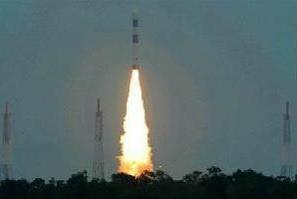April 4, 2014
SRIHARIKOTA: Indian Space Research Organization on Monday successfully launched IRNSS-1B, the second navigation satellite among the seven satellites that will eventually constitute the Indian Regional Navigation Satellite System (IRNSS).

April 4, 2014
SRIHARIKOTA: Indian Space Research Organization on Monday successfully launched IRNSS-1B, the second navigation satellite among the seven satellites that will eventually constitute the Indian Regional Navigation Satellite System (IRNSS).

The 23rd mission of PSLV will put seven satellites in space. These include an Indo-French satellite, SARAL, and NEOSSAT from Canada which will detect and track either near-earth asteroids or satellites in the geostationary orbit.
PSLV-C24 carrying IRNSS-1B blasted off from Sriharikota in Andhra Pradesh at 5.14 pm.
Nineteen minutes after liftoff, PSLV-C24 injected the IRNSS-1B into a preliminary orbit. Later, it will be placed into a sub-geosynchronous transfer orbit (sub-GTO), an elliptical orbit with an inclination of 19.2 degrees with respect to equatorial plane.
Once completed, the IRNSS system will offer navigational services, for both civilian and defense purposes, in India and also 1,500 km beyond its borders. The system is expected to become operational by beginning of 2016.
All the seven satellites will have identical configuration. IRNSS-1B, weighing 1,432 kg at liftoff, is carrying two types of payload – navigation and ranging. Navigation payload will transmit navigation service signals to users. It also contains a highly accurate rubidium atomic clock because keeping accurate time is essential for a positioning system to locate objects without ambiguity. The ranging payload consists of a C-band transponder which helps in accurate determination of the range of the satellite.
This is the 26th flight of Indian Space Research Organization’s primary workhorse, Polar Satellite Launch Vehicle (PSLV). Isro used the 'XL' configuration of PSLV to launch IRNSS-1B.
'XL' configuration allows higher payload and can inject satellites into higher orbits. The version was earlier used for critical missions like Chandrayaan-1, Mars Orbiter Mission and the first IRNSS satellite IRNSS-1A.
Courtesy: TNN







































































































